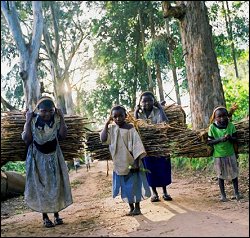As long as the region of North Kivu in the eastern Democratic Republic of Congo (DRC) continues to be a land coveted by many, death and physical abuse will remain the everyday lot of the civilian population. Doctors Without Borders/Médecins Sans Frontières (MSF) has decided to extend its activities by initiating projects in Kayna and Rutshuru, two villages recently exposed to violent clashes. Denis Lemasson, MSF's assistant program head for the DRC, gives this account.
|
– Denis Lemasson
|
Josephine starts to shake. She looks out towards the end of the narrow valley; in her mind's eye she sees a column of armed men. She's starting to mumble, and her voice catches: "The men with the beards, the men with the beards..." Josephine is huddled, her child wrapped around her back. Her arms and feet are covered with dark earth. Fear has altered her features. Her face makes me afraid.
Clothing ripped to tatters and smashed-in doors speak to the intense violence of the looting here in this village. For a month now a militia has been killing, raping, and mutilating any of the residents it has encountered. Josephine is spending the night in a village farther north now, four hours away on foot. In spite of the risks she comes here every day to maintain a few tiny plots of land. This morning she has come with a few other women, former neighbors, to plant some potato tubers.
We're in Bulindi, several miles south of Kanyabayonga. A single, lone man has remained. He has nowhere to go. He sleeps in the brush and spends his days in the village. The man shows us his wounds with an apologetic smile. Another militia had attacked two months before. He was bound; they cut off one of his ears and slashed him deeply in the legs and throat with a machete. The militiamen left him alive. He doesn't know why.

North Kivu province. Photo © Kate Holt |
Josephine and this man could be from any village in this part of North Kivu, where the violence has been focused. From Kayna all the way to Goma, everyday life is evenly punctuated by fear and suffering. The various militias, composed of rival segments of the armies of Uganda, Rwanda, and Kinshasa–still actively financed and supported–clash, loot, rape, and kill. The government armed forces (FARDC), paid little or nothing, also engage in these atrocities against the civilian population. This zone is especially troublesome because it is here that factions who refuse to join the government forces are gathering and regrouping.
The cause of the violence is complex. It stems from interconnecting conflicts, each different in nature. The conflict in Rwanda has shifted to the eastern DRC. The struggle for power in Kinshasa divides and opposes Congo's elites. Social and agrarian conflicts have become militarized, and there is the issue of control over mining resources and trans-border commerce. This province is a microcosm of the many national issues at stake, and it is generating violence.
There can be neither peace nor elections in the DRC without peace in North Kivu. In June, the transition process was delayed. Protest demonstrations led to ten deaths and many dozens of injured. The roadmap for organizing general elections between now and June 2006 calls for an accelerated restructuring of the armed forces and the immediate disarmament of armed foreign groups based in the DRC, especially in the east of the country. There is legitimate concern as to how the process will unfold.
Relief Efforts Hampered
There is total confusion on the ground between combatants and the civilian population. Some militias were created to defend the territories in which their members live. They have become actors in the conflict, attempting to assert their authority over civilians. The victims, far from being persons unknown to their abusers, sometimes belong to the same community, the same village.
The lack of security makes deploying medical assistance in the region difficult. In Ituri, farther north, MSF teams were forced to withdraw from projects on the periphery of Bunia after two aid workers were abducted for a period of ten days. In North Kivu, there is only limited access to zones where it is considered too dangerous to move about, as is the case in southern Kanyabayonga. By increasing the number of our contacts with the group of militias there, however, we have been able to deliver treatment to the majority of the province, despite the obstacles.
Extending Activities Despite the Obstacles
Since mid-June MSF has expanded our activities to include interventions in Kayna's hospital, which has allowed us to treat all emergency cases, both medical and surgical. This rounds out the treatment we are making available, which already includes a therapeutic feeding center, five supplementary feeding centers, counseling services for women who are victims of rape and sexual violence (more than 700 cases treated since September 2004), and a mobile emergency clinic.
In addition, we are initiating a project at Rutshuru on a strip of land squeezed between Virunga National Park and the Ugandan border, a zone hard hit by significant clashes over recent months that have resulted in looting, casualties, rape, displaced populations, malnutrition, and the risk of developing diseases with epidemic potential such as cholera.



